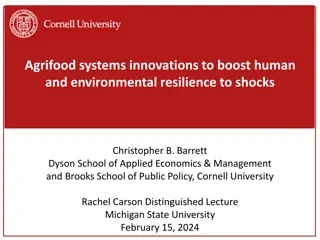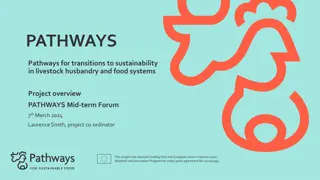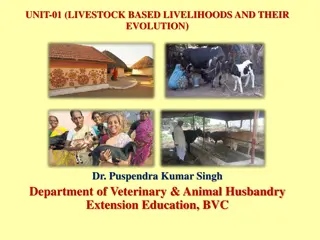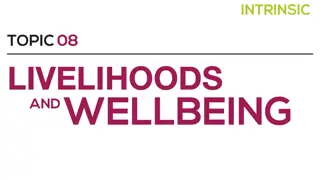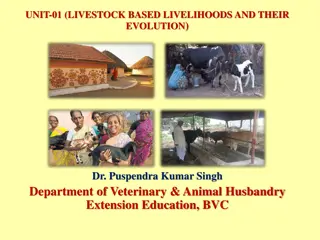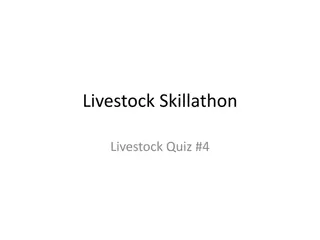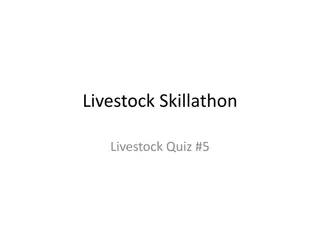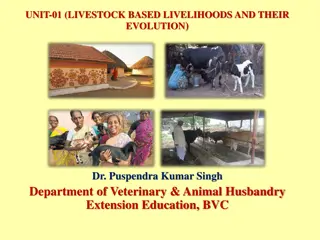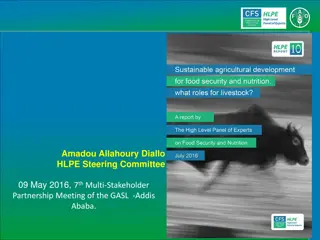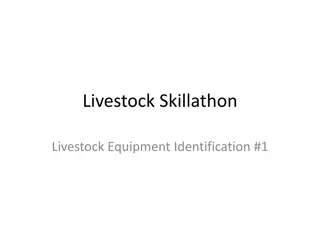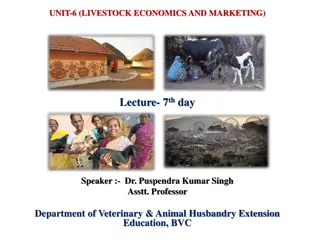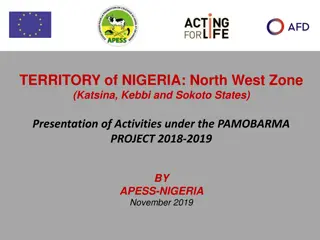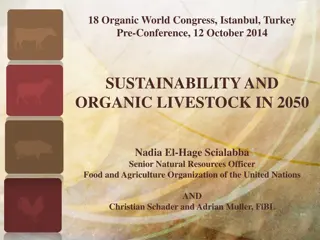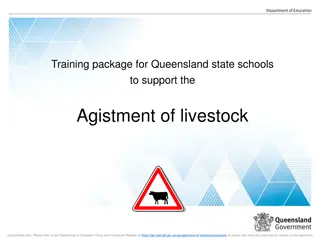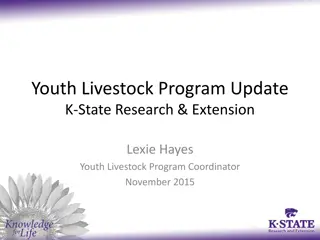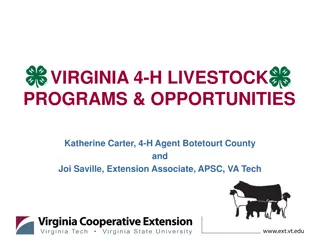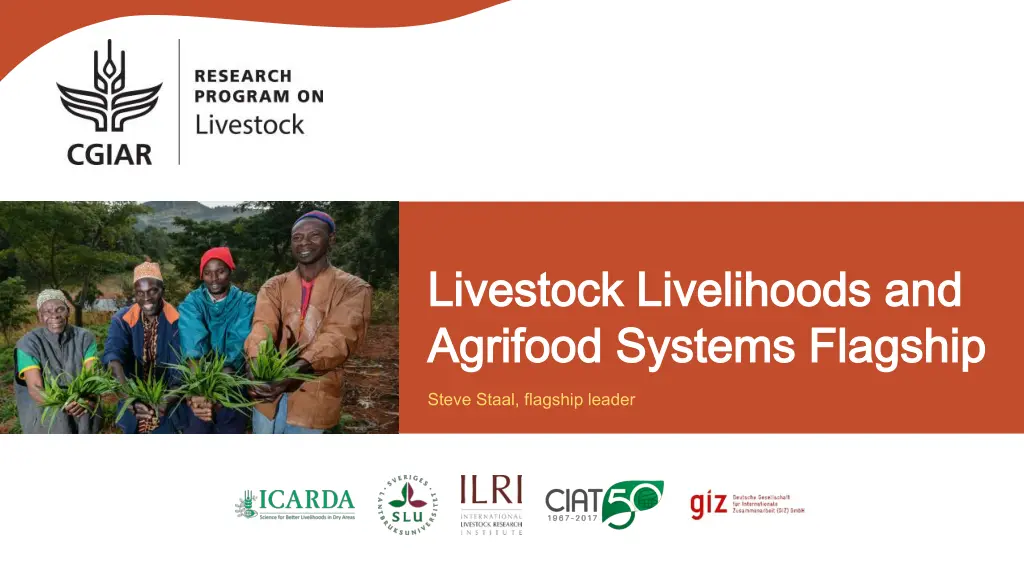
Livestock Livelihoods and Agrifood Systems Flagship
Discover how the Livestock Livelihoods and Agrifood Systems Flagship aims to maximize the role of livestock in improving livelihoods and increasing resilience to risks among women and men smallholder and pastoral producers. Explore their goals, objectives, and outcomes towards 2022.
Download Presentation

Please find below an Image/Link to download the presentation.
The content on the website is provided AS IS for your information and personal use only. It may not be sold, licensed, or shared on other websites without obtaining consent from the author. If you encounter any issues during the download, it is possible that the publisher has removed the file from their server.
You are allowed to download the files provided on this website for personal or commercial use, subject to the condition that they are used lawfully. All files are the property of their respective owners.
The content on the website is provided AS IS for your information and personal use only. It may not be sold, licensed, or shared on other websites without obtaining consent from the author.
E N D
Presentation Transcript
Livestock Livelihoods and Livestock Livelihoods and Agrifood Agrifood Systems Flagship Systems Flagship Steve Staal, flagship leader
Goal and objectives Goal and objectives The goal of the FP is to maximize the role of livestock in improving livelihoods and increasing resilience to risk among women and men smallholder, medium-scale and pastoral producers and their communities in target counties, while also increasing the supply of ASFs Flagship s Flagship s objectives objectives Conduct foresight, impact and policy analysis to set priorities and guide inclusive and sustainable investments by the CRP and by public and private actors. Improve livestock technology and innovation and adoption by ensuring that gender-based analysis informs research design and implementation across the CRP and that delivery and scaling outcomes are equitable. Identify, test, and facilitate livestock-mediated pathways to improve nutrition in resource poor households and their communities. Improve rural livelihoods, through integrated production technologies and institutional innovations in markets and services to improve the performance of animal-source food systems.
Outcomes to 2022 Outcomes to 2022 Gender equity relative to their level of effort (i.e. labour) at household level in the use of, and control of income generated by, livestock related productive assets and resources, impacting 288,000 women across four countries. Improved capacity of 1 million women and young people to participate in livestock related decision-making in five countries. Three million poor people (men and women), in four countries, with an increase in access to more affordable, safe, and nutrient rich animal-source foods. Innovative institutional options that improve resilience that are tested and adopted by national and international research & development partners, increasing the resilience of 356,000 rural livestock-keeping households (1.7 million individuals) in three countries. A 15% Increase, on average in total household income from livestock-related activities, including a 25% increase, on average, in the proportion controlled by women, for 449,000 households (& 2.2 million individuals) in eight countries. 454,000 livestock keeping households (representing 2.2 million individuals, including women) increase their supply of livestock to the market by 15%, on average, in seven countries. Policies and investment within and across four countries at local, country and regional level explicitly include pro-poor livestock mediated development, reaching 2 million livestock keepers & other value-chain actors.
Livestock CRP structure LLAFS within the CRP structure LLAFS within the CRP structure Environment Livelihoods and AFS Genetics GHG emissions Biodiversity impacts Foresight and policy analysis Gender-based analysis Nutrition Integrated technology and institutions Livestock Health Nutrition
Key Key flagship outputs per Cluster of flagship outputs per Cluster of Activity (COA) Activity (COA) Integrated technologies, practices and institutions for improved livestock systems (I. Baltenweck) Policies, foresight and systems analysis (K. Rich) Food and nutrition security through livestock (P. Dominguez-Salas) Gender and social equity (N. De Haan) Improved livestock system modelling and data capturing tools developed with partners Packages of gender-responsive institutional and technical innovations that are known to enhance productivity and equity. Increased understanding of the impact pathways from production of, and access to, animal-source foods, to improved nutrition in rural households (with clusters 2 and 4), with particular focus in own- consumption, income expenditure and women empowerment. Best bet, improved and integrated suite of technologies and management strategies tested and analysed which enhance livelihoods and resilience (or reduce risk) In target CRP countries, empirical estimates of the levels and structure of supply and demand for animal-source foods in the future, under potential alternative development and technology scenarios Gender-transformative approaches developed to address the root causes of gender discrimination, and their effectiveness assessed, and entry points developed within policies, such as the Livestock Master Plans developed under Cluster 1. New inclusive and scalable institutional arrangements developed and tested, that address key needs for enhanced product market and value chain performance, improved delivery of livestock inputs and services. Innovative evidence-based approaches for cost-effective nutrition-sensitive interventions that can improve availability, affordability, access and utilisation of animal-source Impact assessment of these scenarios in terms of productivity, livelihoods, income, diet diversity, nutrient availability, equity, water use, and GHG emissions. Gender-sensitive indicators and methodologies developed for assessing progress on gender strategic change (e.g. transformation of gender norms or empowerment). Harmonized ex ante and ex post impact assessments of selected technologies, practices and institutional arrangements across production systems and value chains Guidance on livestock policy, technology and investment priorities and strategies for the CRP and the CGIAR
Color key Color key Green: Green: already achieved Yellow: Yellow: will be achieved by end 2017 Red: Red: delayed Update Update on on progress progress towards towards the 2017 POWB the 2017 POWB 1.1 Empirical estimates of the levels and structure of supply and demand for animal- source food, obtained by combining market and household survey data with production estimates, applied to foresight models. 1.2 Systems analysis tools, models and datasets, which will contribute to informing evidence-based priority setting and investment across the CGIAR and among governments, donors and other partners. 1 journal article on ASF supply/demand and food security in target Livestock CRP countries 1 report on drivers of uptake, and impact of, the infection and treatment method (ITM) vaccine for East Coast Fever uptake in Tanzania 1 report on characteristics of adopters of Brachiaria planted forage 1.3 Evidence to inform policies analysed and disseminated, with a view to enhancing livestock contributions to food and nutrition security and livelihoods and addressing the constraints faced by women and young people as well as men. Rwanda Livestock Master Plan report and policy brief Cluster 1: Systems analysis for priority setting and policy Tanzania Livestock Master Plan report and policy brief Working paper on the role of livestock in East African community economies Report on evidence on the contribution of livestock to livelihoods Review report on policies and regulations affecting small ruminant value chain performance performance in Ethiopia
Color key Color key Green: Green: already achieved Yellow: Yellow: will be achieved by end 2017 Red: Red: delayed Update Update on progress towards on progress towards the 2017 POWB the 2017 POWB 2.1 Packages of gender-responsive institutional and technical innovations that are known to enhance productivity and equity. 1 paper published on forage innovation and link to food security 1 journal article on 'emerging gender issues' in selected livestock value chain published CRP gender strategy revised 2.2 Gender-transformative approaches developed to address the root causes of gender discrimination, and their effectiveness assessed. 2.3 Youth strategy Cluster 2: Gender and social equity Youth strategy for livestock CRP developed and published 2.4 Gender-sensitive indicators and methodologies developed for assessing progress on gender strategic change (e.g. transformation of gender norms or empowerment). Revised livestock module for WEAI Paper published on women empowerment in livestock index
Color key Color key Green: Green: already achieved Yellow: Yellow: will be achieved by end 2017 Red: Red: delayed Update Update on progress towards on progress towards the 2017 POWB the 2017 POWB 3.1 Diets and related decision-making characterized in target communities and novel evidence on the role of animal-source food in enhancing nutrition produced. 1 tool and dataset available to assess ASF consumption and nutritional impacts of nutrition of livestock interventions 1 manuscript on the role of ASF in Uganda with an emphasis on pig products 1 manuscript on participation in dairy business hubs and women empowerment and household nutrition from MoreMilkIT in Tanzania 1 project report on social and behavioural communication strategy for dairy consumption in Kenya and Tanzania 3.2 Impact pathways from production of, and access to, animal-source food, to improved nutrition in rural households assessed within the target interventions (with clusters 2, 4 and 5). 3.3 Innovative evidence-based options on cost-effective nutrition-sensitive interventions that can improve availability, affordability, access and utilisation of animal-source food to poor producers and consumers designed and tested Cluster 3: Enhanced nutrition through livestock 1 RCT design protocol to assess the nutritional impact of nutrition intervention finalized
Color key Color key Green: Green: already achieved Yellow: Yellow: will be achieved by end 2017 Red: Red: delayed Update Update on progress towards on progress towards the 2017 POWB the 2017 POWB 4.1 Livelihood systems analysed and understood in terms of the roles of livestock incomes and assets, productivity, resilience, nutrition, gender and social relations. Paper on trade off of biomass use mixed crop-livestock systems under conservation agriculture in Tunisia Paper on role of livestock in enhancing resilience capacities of farmers in the drylands Tunisia, Jordan, Morrocco Assessment of pig farming competitiveness In Vietnam (1 report + 1 proposal) Welfare impact of market information and collective action among small ruminant keepers in Ethiopia 4.2 Optimal herd management practices for adapting to climatic variability and climate risk in pastoral systems developed and underpinned by acceptable trade-offs between productivity improvement, economic and social considerations and environmental impacts. 4.3 Optimized suite of technologies, management strategies, and institutional arrangements tested and analysed which enhance livelihoods and nutrition equitably for women, men and young people from livestock- mediated on-farm and off-farm economic opportunities in various settings. Cluster 4: Optimizing livestock systems for productivity and resilience 1 paper on economic performance of Indigenous micro-organism (IMO) pig production systems versus conventional systems in Uganda 1 ex-ante assessment paper on impact of ASF biosecurity on pig producer margins in Uganda Report on integrated technology packages defined and implemented for 7 small ruminant VC sites Report on technologies to enhance SR VC performance addressing identified constraints in Pakistan 1 paper on SR fattening in Pakistan submitted
Color key Color key Green: Green: already achieved Yellow: Yellow: will be achieved by end 2017 Red: Red: delayed Update Update on progress towards on progress towards the 2017 POWB the 2017 POWB 5.1 The performance of livestock market systems for products, inputs and services analysed and key barriers identified, 1 VCA report on hides and skins in Somalia 1 report on livestock bones value addition in Somalia 1 report on business model for milk cooling technology adapted to Tunisian milk market incl. cost benefit 1 report on barriers to uptake of improved dairy technologies Tools for assessing business leadership/governance, and capacities of dairy coops in Rwanda. Tools for assessing costs and benefits of SOQ initiatives for milk supply in Rwanda dairy. 1 capacity assessment report for dairy coops in Rwanda Goat VCA Report India Cluster 5: Effective markets and institutions 1 paper on factors affecting progress toward dairy producer organisation sustainability 1 journal article on institutional arrangements tested under Livestock & Fish CRP 5.2 New inclusive and scalable institutional arrangements developed and tested, easily available to women and youth, Lessons on sustainable smallholder dairy VC delivery in Tanzania Paper on learning effectiveness legacy from Humid-Tropics 1 Case study on use of ToC in Tanzania to demonstrate how R4D can be designed and implemented for greater impact
How 2017 activities informed How 2017 activities informed 2018 plans 2018 plans All 2017 activities are being conducted through bilateral/W3 projects and ILRI Reserves as no W1/2 funds are available. Through these resources we were able to maintain most core staff and skills. The rewriting of our Flagship proposal led to a change in the Cluster structure (4 vs 5), and some streamlining where there had been potential overlaps. Our experience to date has also led us to focus on 4 countries and 3 systems Ethiopia small ruminants, Tanzania dairy, Uganda and Vietnam pigs. The following changes were applied to clusters: Policy and systems Policy and systems Gender Gender Nutrition Nutrition Technology and institutions Technology and institutions Previously the on-farm technology integration and institutional innovations were separate clusters. They have now been combined into this new cluster. New emphasis on working with other modelers (FAO) to improve global livestock models, and also improvement to national/sub-national modeling (LSIPT, SD). All policy work now here. Gender work now increasingly integrated into other FPs, and overall aims have been streamlined Due to lack of resources and capacity, aims are now less ambitious
COA1 Outcomes and Milestones COA1 Outcomes and Milestones Outcomes to 2022 1. investment and ex-ante impact assessments to guide priority setting, investment and policy development for the livestock sector in five priority countries, and within the Livestock CRP. National and international research partners and policymakers use analyses of livestock-sector dynamics, 2. problems based on their mandate areas International researchers and agencies use improved livestock system modelling tools, and apply them to new Milestones Improved data protocols, impact indicators and new model structures will be developed and documented (2020) impact assessments to guide priority setting for the livestock sector in three priority countries (2020). National and international research partners use analyses of livestock sector dynamics, investment and ex-ante based on bilateral support, and begin to adjust investments accordingly. National partners and their donors participate in new Livestock Master Plan development in three priority counties, in three priority countries (2020) Livestock system modelling tools and databases are improved with national and international partners to fit needs
COA2 Outcomes and Milestones COA2 Outcomes and Milestones Outcomes to 2022 benefits of including gender equity considerations In the development of livestock projects and planning at community and national level (Ethiopia, Kenya, Nicaragua, Vietnam) Policy- or decision-makers in 4 priority countries use the packages developed and the evidence on the supportive approaches (using the evidence from the strategic gender research done under the CRP). Local or national development partners in four priority countries adopt gender-transformative and youth- Milestones Gender responsive livestock innovations tested and their impact assessed in two priority countries (2020) considerations (2020). Policy- or decision makers in two priority countries use evidence on the benefits of including gender equity their impact assessed in 4 priority countries (2022). Gender-transformative approaches that also support young people have been developed and tested and
COA3 Outcomes and Milestones COA3 Outcomes and Milestones Outcomes to 2022 adopt the most successful approaches for enhancing livestock-mediated nutritional impact, including institutional arrangements and behavioural change, in 3 priority countries. Local and national development actors, government agencies, and the private sector invest in and Milestones Local and national development actors and government agencies adopt tailored options for nutritional impact through livestock development, including behavioural approaches, within communities in Kenya (2020) cost-effective institutional arrangements and
COA4 Outcomes and Milestones COA4 Outcomes and Milestones Outcomes to 2022 1. institutional arrangements, taking the multiple functions of livestock into account. Livestock communities across four priority countries apply tested technologies, management strategies and 2. institutional arrangements to enhance competitiveness and inclusiveness. Milestones Livestock communities across two priority countries apply tested technologies, management strategies and institutional arrangements (2019). Development partners, private sector and government agencies across 4 priority countries apply innovative institutional arrangements to raise competitiveness and inclusiveness (2020) Three impact assessment studies conducted on Livestock CRP promoted technologies or institutional arrangements (2022) Development partners, private sector and government agencies in two priority countries apply innovative
COA1 COA1 Logframe Logframe CLUSTERS OF ACTIVITIES ACTIVITIES Deliverables 2018 Key international partnership and joint strategy is developed to achieve improved global and national livestock modelling tools by 2020. Improved livestock system modelling and data capturing tools developed with partners In target CRP countries, empirical estimates of the levels and structure of supply and demand for animal- source foods in the future, under potential alternative development and technology scenarios Strategic analysis of ASF supply and demand to 2030 and 2050 in a set of target CRP countries in SSA and Asia (joint CRP effort conducted with PIM/IFPRI) Cluster 1: Policies, foresight and systems analysis Impact assessment of these scenarios in terms of productivity, livelihoods, income, diet diversity, nutrient availability, equity, water use, and GHG emissions. Same as above Comprehensive trade-off models between competing uses for crop residue biomass developed and simplified for wider use for Conservation Agriculture-livestock systems (linked with CRP Wheat) Guidance on livestock policy, technology and investment priorities and strategies for the CRP and the CGIAR Livestock Master Plans (LMP) and/or Livestock Sector Analyses, in and Rwanda (MARD and FAO), and Uzbekistan (MoA)
COA2 COA2 Logframe Logframe CLUSTERS OF ACTIVITIES ACTIVITIES Deliverables 2018 Benchmark publication on gender and livestock to identify frontiers in research and development Paper on linkages between gender empowerment and nutrition Packages of gender-responsive institutional and technical innovations that are known to enhance productivity and equity. Publication on gender and empowerment as related to species and business Paper on understanding the level of women s engagement in agricultural innovation process Cluster 2: Gender and social equity Gender-transformative approaches developed to address the root causes of gender discrimination, and their effectiveness assessed, and entry points developed within policies, such as the Livestock Master Plans developed under Cluster 1. Gender-sensitive indicators and methodologies developed for assessing progress on gender strategic change (e.g. transformation of gender norms or empowerment). Research initiated on livestock as a core business for women for empowerment, and the implications At national level work initiated on integrating gender in the livestock MasterPlan and development of tools Development of gender entry points (packages) for the 4 priority countries and identification of investable options for women in livestock development through country assessments
COA3 COA3 Logframe Logframe 1 paper on Gaps in macronutrient intake and prevalence of undernutrition among men, women, and children in Uganda, with a focus on livestock keeping households Increased understanding of the impact pathways from production of, and access to, animal-source foods, to improved nutrition in rural households (with clusters 2 and 4), with particular focus in own-consumption, income expenditure and women empowerment. Cluster 3: Food and nutrition security through livestock 1 paper based on the SBCC qualitative work in Kenya and Tanzania Innovative evidence-based approaches for cost- effective nutrition-sensitive interventions that can improve availability, affordability, access and utilisation of animal-source 1 paper on Looking beyond income: the impact of dairy hubs on human nutrition in Tanzania
COA4 COA4 Logframe Logframe CLUSTERS OF ACTIVITIES ACTIVITIES Deliverables 2018 1 paper on Sweet potato wastages in major pig producing districts in Uganda: an opportunity for investment in silage technologies Best bet, improved and integrated suite of technologies and management strategies tested and analysed which enhance livelihoods and resilience (or reduce risk) Report on financial feasibility of prioritized technologies for enhancing SR VC performance in Ethiopia (Haramaya University, Ethiopian NARS) Cluster 4: Integrated technologies, practices and institutions for improved livestock systems 1 paper on Types of interactions and alliances developing in the regional pig multi-stakeholder platforms in Uganda: A network analysis New inclusive and scalable institutional arrangements developed and tested, that address key needs for enhanced product market and value chain performance, improved delivery of livestock inputs and services. 1 paper on Drivers of dairy producers organisations sustainability in East Africa Harmonized ex ante and ex post impact assessments of selected technologies, practices and institutional arrangements across production systems and value chains Report on effect of integrated technology packages for enhancing SR VC performance on livelihoods
Cross Cross- -cutting work under this Flagship in cutting work under this Flagship in 2018 2018 Cross Cross- -Cutting Cutting staff (many of them are also LLAFS staff staff (many of them are also LLAFS staff Iddo Dror (ILRI, capdev) Brian Kawuma (ILRI, comms) Wole Kinari (ICARDA, gender) Birhanu Lenjisu (ILRI, gender- genetics) Juliet Kariuki (ILRI, gender- feed) Wouter Kleijn (ILRI, youth) Nicoline de Haan (ILRI, gender) Alessandra Galie (ILRI, gender) Jane Poole (ILRI, M&E) Nils Teufel (ILRI, IA) Michael Kidoido (ILRI, IA) COA 1 COA 3 COA 4 COA 2 Capacity development for partners to integrate gender in their activities Impact assessment of gender interventions Relationship between nutrition and women empowerment Capacity development support to develop SBCC strategies Gender and youth integrated in institutional arrangements activities Impact assessment of specific value chain interventions Assess how to integrate gender in livestock master plans modelling Capacity development on modelling for national partners Supporting advocacy work (communication) on role of livestock in livelihoods
Budget per CoA W1/2 and Budget per CoA W1/2 and W3/ W3/bilaterals bilaterals W1/2 = $1,476,200 W3/bilaterals = $6,347,500 Cluster Cluster description W1/2 W3/Bilateral ILRI ICARDA $51,675 ILRI $250,971 ICARDA Policies, foresight and systems analysis $333,008 $0 1 Gender and social equity Food and nutrition security through livestock Integrated technologies, practices and institutions for improved livestock systems $225,309 $175,434 $438,335 $252,471 5,995,615 $0 $0 $32,000 $0 $0 2 3 4 $0 $68,975 Total 1,172,086 $304,146 6,278,586 $68,975


